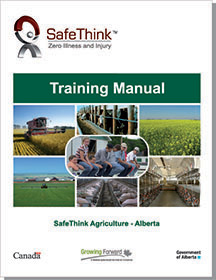
Prevention
Keeping your family, workers, and self safe all day, every day!
|
Preventing Illness and Injury in the Agricultural Industry!
Agriculture is a dangerous industry. Agriculture ranks as the third most hazardous industry in Canada with respect to rates of fatal injury.
Farming and ranching are completex, physically demanding, and stressful. Preventing illness and injury is important to having a healthy, safe, and productive operation.
In collaboration with the provincial department of Alberta Agriculture and Rural Development, we have customized SafeThink for the Alberta agricultural industry.
SafeThink Agriculture - Alberta
Farmers and ranchers have contributed to the development of the manual. The training manual uses agriculture-specific examples and places a strong emphasis on hazards and the conditions, actions, and events that lead to or create hazardous situations. Options for controls to prevent illness and injury are provided. Participants apply the SafeThink strategy to their operations so that the strategy has meaning and value.
Thinking and planning ahead are encouraged. Human factors affecting safety are also discussed. |
Health and Safety in the Agricultural Industry
Prevention: there is a better way!
The agriculture industry is complex. There are major differences among operations that produce cereal and oil crops, dairy and beef cattle, hogs, poultry, and vegetable crops. Operations vary in size and type, ranging from the typical family farm or ranch to very large production facilities with 100 or more employees.
Many injuries and fatalities occur on farms and ranches. Personal costs of illness, injuries, and fatalities are extremely high. The loss of a child, spouse, or other loved one is devastating to family members. The loss of a friend or co-worker can have similar long-term emotional effects.
Work-related illnesses and injuries create pressures on family members. In addition to the pain, worry, and grief, there are expenses and loss of income. Long-term disabilities reduce a person’s quality of life and can create a burden on family members.
Agriculture is a dangerous occupation when compared to other Canadian industrial sectors. Agriculture ranks as one of the most hazardous industries in Canada with respect to rates of fatal injuries. In terms of absolute numbers of fatalities, there is no more dangerous occupation (Pickett et al., 1999). Across Canada from 1990-2005, there were 1769 agriculture-related fatalities (Issacs, C. (2008). Agriculture Fatalities in Canada 1990-2005).
Too often, we rely on treatments and rehabilitation to deal with illness and injury. As government health care budgets continue to escalate, a greater emphasis needs to be put on prevention. Certainly, the agricultural industry needs to do better.
When I was young, my parents placed a lot of emphasis on prevention. In those days, there were no safety nets for us—there was no universal health care, no workers compensation, and medical insurance was out of the question. We would only go see a doctor if mother’s home remedies or nature couldn’t cure the problem.
Mother’s approach to safety was to have lots of rules that were reinforced with consequences, some natural and others imposed. Dad, a farmer, took a different approach—he placed a lot of emphasis on thinking and talking things through before and while working. What had to be done? How well was it to be done? How it had to be done? Was there a more efficient way that took less effort? What were the safety concerns? What could go wrong? Watch out for this. Pay attention to that.
When I left home and worked in construction, I got a rude awakening. Often little direction was provided. It was hurry up and get the job done. Safety was just common sense. Of course many of us younger workers didn’t have common sense—we had never worked in construction before. We learned by trial and error, sometimes with unfortunate consequences. Over time, we learned to create generalities for hazards: all pointed objects can hurt you under the right conditions, actions, and events; all pinch points can hurt you under the right conditions, actions, and events; all rotating objects can hurt you under the right conditions, actions, and events. Having learned the hazards as generalities, we could quickly identify hazardous situations that could harm us under the right conditions, actions, and events. Is that common sense?
The famous architect, Frank Lloyd Wright, said, “There is nothing more uncommon than common sense.” Too often, I hear farmers and ranchers say that safety is just common sense. Can you imagine holding a new born baby and saying with pride, “You’re so smart. You have common sense.” We are not born with common sense. At best, it could be learned. If common sense is so good, why does the agricultural industry have such a dismal safety record? Fortunately, we no longer have to learn by trial and error to keep ourselves and others safe—there is a better way.
|
|
In the agricultural industry, there are two primary approaches to safety: having lots of rules and providing knowledge about specific hazards. Unfortunately, rules and knowledge are essential but not sufficient to prevent illness and injury. We all need a structured critical thinking strategy to apply our knowledge with rigor to identify, predict, and control hazardous situations. It’s about the quality of the thinking. |
Some people are better than others at planning and thinking through their work to work effectively, efficiently, and safely. Everyone can learn to be better at identifying, predicting, and controlling hazardous situations. Everyone can learn to be better at planning and thinking ahead to prevent illness and injury.
There is a new training program for farmers and ranchers to learn a structured critical thinking strategy that not only improves safety it contributes to working more effectively and efficiently. Why? Because the strategy requires you to think through the work with more rigor, before working, while working, and after the work is done.

|
HDC Human Development Consultants Ltd. (HDC) in collaboration with the department of Alberta Agriculture and Rural Development has tailored HDC’s SafeThink program to farmers and ranchers. It is a safety program that emphasizes prevention. With SafeThink, we should never again have to ask ourselves after an incident, “What was that person thinking?” |
SafeThink has several features that make it so effective:
-
it categorizes the hazards to form a framework to thinking through the work to identify, predict, and control hazardous situations
-
it identifies hazards as generalities, reducing the complexity of the thinking process
-
it requires you to ask yourself questions. When you ask yourself a question, it tends to beg an answer. It helps keep you alert and more focused on the work. And for young people, they become more comfortable in asking questions not only about safety but also about the operation.
-
it gives you a structured thinking process to rigorously think through the work to identify the hazards, conditions, actions, and events that lead to or create hazardous situations. You will also work more efficiently.
The training program also addresses human factors such as reasons for safe and unsafe behavior, fatigue, and distractions that increase the risk of an incident and suggests ways to deal with the human factors. The beauty of SafeThinking is that it can be used continually throughout the day, at work, at home, while driving, and on vacation. You think on your feet, continually identifying and predicting hazardous situations. It’s in your head and you can’t leave home without it.
When people learn to SafeThink, they internalize and personalize the strategy to their work and work environments. They own the thinking strategy. And, when people own the strategy, they tend to encourage others to be safer too.
There is an interesting survey by Farm Credit Canada (2008, 2011) about safety attitudes of agricultural operations. My understanding of the findings is that agricultural operators were concerned about safety. When it came to taking action, however, operators were concerned for the safety of children but not particularly concerned for their own safety. In general, they are not prepared to make a significant effort to improve safety in their operations. That sounds like lip service, doesn’t it? Many operators believe they’re safe enough when safety statistics say otherwise. It’s time for a rethink to protect what’s most important, the wellbeing of others and you. How committed are you to ensuring that you, your family, and workers are safe? What actions have you taken recently to improve safety in your operation? Have you been leaving improvements in safety in your operation until tomorrow? Tomorrow never comes.
Safety is not a priority, it’s a commitment. I recall that, in my business, one day a customer made a special request. “Everyone, stop what you’re doing and work on this project, it’s a priority.” The next day a different customer made a request. “Everyone, stop what you’re doing and work on this new project.” Priorities can change!
Glen Blahey of the Canadian Agriculture Safety Association (CASA) told me an interesting story about commitment. When he and his fiancé were taking pre-marriage lessons, the priest asked, “What’s the difference between a contribution and a commitment?” The priest went on to say, “Think of a breakfast of eggs and bacon. The chicken made a contribution, the pig was committed.” Commitment to safety is when you don’t compromise on safety measures for yourself and others regardless of the demands and challenges of the day. Commitment is when you continually take action to improve the safety of your operation.
Some agricultural operations have demonstrated a real commitment to the safety and well being of all people in their operation. They have developed safety, environmental, and emergency response plans. They have upgraded their facilities to be safer. Some operations have written procedures for critical tasks. Some have developed structured training, training that requires trainees to demonstrate and prove that they are competent to perform the tasks safely, effectively, and efficiently. Now that’s commitment!
Everyone, young and old, can be better at preventing illness and injury. Young people are fast learners; they’re smart. They can quickly learn to SafeThink. Yes, they are prone to taking risks but SafeThinking can give them pause to consider the consequences and controls.
We more seasoned people can learn too. Although our thinking may slow down, our thinking skills usually remain effective. As a more seasoned person, it’s time for you to give up your bad safety habits and shortcuts and develop better safety habits. Take more time to think things through. Stop once in a while when working to think ahead. What can go wrong? How can I get injured? Keep in mind, with age, strength, coordination, response time, eye sight, and hearing can diminish. Consider getting help to do some tasks and have others do the difficult tasks. Learning to SafeThink can help too. Walk the talk. Take action. Don’t put people in the situation when some day they will have to ask, “What was he thinking?”
Prevention of illness and injury in the agricultural industry will be most successful within a culture of safety—a culture in which everyone, young and old, takes measures to prevent illness and injury. In a culture of safety, people are vigilant and mentally engaged—throughout the day—in identifying, predicting, and controlling hazardous situations to prevent illness and injury. Yes, all of us can do better at managing risk to prevent illness and injury.
Gordon D. Shand
www.safethink.ca
 |
Gordon has been developing training and educational programs for most of his career. He, along with a lot of help from staff and industry, created SafeThink, a structured critical thinking strategy that everyone can use to prevent illness and injury all day, every day.
|
|




